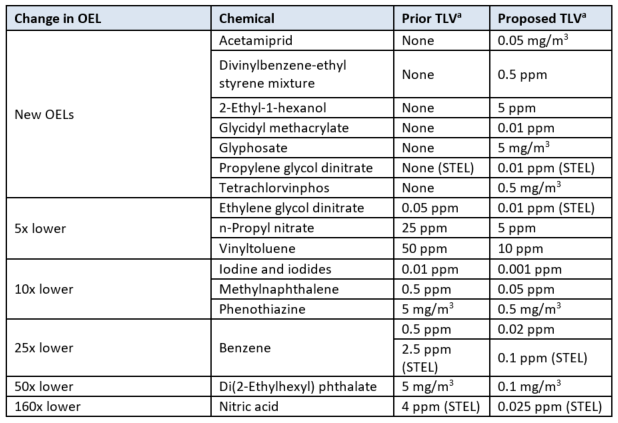December 2022
Gradient is pleased to announce that Tim Verslycke will serve as President of the International Board of Environmental Risk Assessors (IBERA) for 2023-2024.
Founded in 2021 by the Society of Environmental Toxicology and Chemistry (SETAC), IBERA is an independent, non-profit entity registered in Brussels, Belgium. IBERA promotes scientific progress in environmental risk assessment, encourages education and training, and established the first international certification program in environmental risk assessment.
As President, Dr. Verslycke will work with the other elected officers and Council members to implement the goals of the IBERA program in the coming two years. Dr. Verslycke is also one of the founding members of IBERA.
European Union Proposes to Add New Hazard Classes to its CLP Regulations for Endocrine Disrupting Chemicals
On September 20, the European Commission (EC) published a proposal to amend the European Union’s Classification, Labelling and Packaging (CLP) Regulation of substances and mixtures (EC No. 1272/2008), and sought stakeholder feedback on this proposed amendment by October 18. The proposal identified four new hazard categories for endocrine disrupting chemicals, including “known or presumed” (Category 1) and “suspected” (Category 2) endocrine disruptors for human health or the environment. The proposal also describes a range of criteria to be used for classification, and advocates for the use of a weight-of-evidence approach informed by expert judgment.
Given that the proposed new hazard categories have not been adopted under the United Nations’ Globally Harmonized System of Classification and Labelling of Chemicals (GHS), it is yet unclear how the EC proposal will impact GHS and other chemical regulations. Further, given a lack of technical guidance for the proposed CLP classifications, the type of endocrine-related data that should be used and how it will support classification decisions is currently uncertain.
Regardless of these uncertainties, it is clear that enactment of the EC’s proposal would result in significant impacts to businesses, such as reclassification and labeling of substances and mixtures containing endocrine disruptors, updates to safety data sheets, revised registrations, etc. Even if the CLP proposal is not enacted in its current form, it is critical for industry stakeholders to evaluate the impact of this proposal, or similar future regulatory proposals, on their products.
For more than two decades, Gradient scientists have been at the forefront of the topic of endocrine disrupting chemicals, including drafting technical documents to support the United States Environmental Protection Agency’s Endocrine Disruptor Screening Program, conducting weight-of-evidence reviews, overseeing product portfolio vulnerability assessments, and incorporating endocrine disruption into product stewardship programs. To discuss this issue further, please contact us (see the list below).
Gradient will be hosting a webinar in the near future to discuss the potential impact of the EC’s recent CLP proposal. This webinar will discuss recommended actions businesses can take, with examples from past and ongoing projects. Watch for more information on this webinar, which will be coming soon.
Topics: Endocrine Disruption, Hazard Categories, Safety Data Sheets, Chemical Registration
Contact:
Ari S. Lewis, M.S.
Principal
alewis@gradientcorp.com
Tim Verslycke, Ph.D.
Principal
tverslycke@gradientcorp.com
Ifeoluwa A. Bamgbose, M.S. passed the American Board of Toxicology examination to become a Diplomate of American Board of Toxicology (DABT).

Dr. Rachel Y. Chang passed the American Board of Toxicology examination to become a Diplomate of American Board of Toxicology (DABT).
Update on OELs in Development
Occupational exposure limits (OELs) are airborne concentrations of chemicals recommended as guidance or promulgated as regulatory exposure limits for the protection of worker health. Periodically, OEL-setting organizations develop new limits for chemicals that lack them and re-evaluate existing limits, which they either retain or revise. Below, we provide updates on the current work of the major OEL-setting organizations in the US.
American Conference of Governmental Industrial Hygienists (ACGIH) Threshold Limit Values (TLVs)
ACGIH’s TLV-Chemical Substance (TLV-CS) Committee identifies chemicals and physical agents for which to develop or revise TLVs and places them on its “Under Study” list. Every year, the Committee issues proposed new or revised TLVs in the form of Notices of Intended Changes (NICs).
The Notices of Intended Changes Issued by ACGIH

Notes: STEL = Short-Term Exposure Limit. (a) Values are time-weighted averages (TWAs), unless otherwise noted.
In September 2022, ACGIH announced several changes to its TLV development process for 2023: the “Under Study” list will no longer be tiered, the Committee will be able to add chemicals to the list at any time, and comment periods for NICs will be offered twice per year, each lasting three months.
Occupational Safety and Health Administration (OSHA) Permissible Exposure Limits (PELs)
OSHA has not indicated that any PELs are currently in development.
National Institute for Occupational Safety and Health (NIOSH) Recommended Exposure Limits (RELs)
Currently, NIOSH notes that RELs for two chemicals are “under development” – toluene diisocyanate and 1-bromopropane. However, NIOSH last updated the “Peer Review Agenda” information for these RELs in 2016.
Occupational Alliance for Risk Science (OARS) Workplace Environmental Exposure Levels (WEELs)
This year, the OARS WEEL Committee developed a new WEEL for difluoroethylene, (E)-1,2 (HFO-1132 [E]) (350 ppm). WEELs for dimethyl ether and triethylenetetramine (TETA) are currently in the public comment stage.
As part of OEL development, many OEL-setting organizations offer opportunities for organizations to provide comments and/or submit data or other information about chemicals as part of their OEL development processes. Gradient scientists understand occupational exposures and the studies upon which OELs are based; we can support clients who want to contribute to the OEL-setting process for chemicals of importance to them. We provide information, analysis, and advice on a wide range of occupational health and risk issues.
Contacts:
Lisa A. Bailey, Ph.D.
Principal Scientist
David G. Dodge, M.S., DABT, CIH
Principal Scientist
Julie C. Lemay, M.P.H.
Senior Environmental Health Scientist
Tom A. Lewandowski, Ph.D., DABT, ERT, ATS
Principal
Christopher M. Long, Sc.D., DABT
Principal
Gradient is pleased to announce that Chris DesAutels has joined the firm as a Principal Scientist. Chris is an air modeler with over 20 years of experience simulating the transport of air pollutants, conducting air quality modeling studies, and performing analyses of meteorological data. His experience covers a variety of applications and industry sectors, including transportation, agriculture, fugitive dust, odors, and dense gas releases. He has also been involved in air model software development and evaluation, including development work on the CALPUFF dispersion model.
In addition, Gradient welcomes Dr. Amy Hrdina who joins Gradient after completing a postdoc at Massachusetts Institute of Technology. Dr. Hrdina is an atmospheric chemist with a broad background in materials and analytical chemistry. She has conducted several field campaigns monitoring criteria pollutants, along with studying atmospheric ammonia and its role in secondary particle formation.
These additions to our team complement Gradient’s robust capabilities in exposure modeling and risk assessment. See more on Gradient’s Air Quality services.
Increased Funding Supports Fenceline Monitoring Near Environmental Justice Communities
Topics: Environmental Justice, Fenceline Air Monitoring, Air Quality and Emissions, Industrial Emissions Impacts
Recent funding for community and fenceline air monitoring presents significant opportunity to better understand and mitigate industrial emissions impacts on neighboring communities, especially within environmental justice communities.
With the passage of the Inflation Reduction Act of 2022, community and fenceline air monitoring will see a significant increase in funding, especially within environmental justice communities. United States Environmental Protection Agency (US EPA) will be provided with $117.5 million for fenceline and community monitoring efforts through 2031, with another $3 million to be allocated to installing air quality sensors in low income and disadvantaged communities. In addition, Environmental and Climate Justice Block Grants will provide $3 billion in potential funding for fenceline and community monitoring projects put forward by local governments and community-based non-profits through 2026.
This funding builds on US EPA’s growing focus on using fenceline and community monitoring to better understand and mitigate industrial emissions impacts on neighboring communities. Initial passage of US EPA’s Refinery Rule in 2015 instituted benzene fenceline monitoring requirements for petroleum refineries. Subsequent state actions (California AB1647, Colorado HB21-1189) and US EPA settlement agreements have gradually expanded this practice to other pollutants and industries. The new funding of the Inflation Reduction Act can be expected to greatly expand the collection and availability of monitoring data, with an increase in the number of monitoring networks designed and run by government and nonprofit groups.
Understanding the relative contribution of different sources of air emissions and assessing cumulative impacts from chemical and nonchemical stressors will be important.
Expanded fenceline monitoring represents a significant opportunity to better understand and control emissions. Fugitive sources, leaks, and accidental releases can be better quantified and mitigated, allowing facilities the opportunity to rectify short-term problems before they represent long-term risks to the community. However, the public availability of this data comes with challenges in effective risk evaluation, community engagement, and risk communication, particularly in the context of understanding the relative contribution of different sources of air emissions and assessing cumulative impacts from chemical and nonchemical stressors.
Gradient is positioned to assist clients at this intersection of industrial activity, government policy, and community engagement. Our scientists are at the forefront of air quality, air emissions, and risk assessment, and excel at interpreting and communicating the meaning of complex data to community and government agencies. If you have questions about how expanded fenceline monitoring may impact your industry, please contact Gradient.
Contact:
Christopher DesAutels, M.S.
Principal Scientist
cdesautels@gradientcorp.com
Ari S. Lewis, M.S.
Principal
alewis@gradientcorp.com
Julie C. Lemay, M.P.H.
Senior Environmental Health Scientist
jlemay@gradientcorp.com
Chris M. Long, Sc. D., DABT
Principal
clong@gradientcorp.com
Links:
Inflation Reduction Act of 2022
Gradient will have six presentations at the MGP Conference 2022, taking place September 28-30 in Chicago, Illinois. Click the links below to view the presentation and poster abstracts.
Gradient’s 2022 MGP Presentations and Posters:
“Soil Vapor Fingerprinting to Differentiate Petrogenic and Pyrogenic Sources”
James Rice
Session 1: Innovative Site Characterization Techniques
09/28/22 @ 1:25 pm-1:45 pm
“Weight-of-Evidence Approach to Estimate Release Timing at a Former MGP Site”
John Kondziolka
Session 1: Innovative Site Characterization Techniques
09/28/22 @ 2:25 pm-2:45 pm
“Environmental Justice and the MGP Community Programs and Screening Tools”
Matthew Mayo
Session 7: Community Relations
09/29/22 @ 4:15 pm-4:35 pm
“Risk-based Remediation Case Study”
Meghna Swamy
Session 8: Remediation Case Studies
09/30/22 @ 8:45 am-9:05 am
“Historical Assessments of Former Manufactured Gas Plant Sites”
Anna Engel
Poster
“Key Findings Regarding Soil Gas Sampling at Former Manufactured Gas Distribution Holder Sites”
Kurt Herman
Poster
Gradient will have four presentations at the SETAC North America 43rd Annual Meeting, taking place November 13-17, 2022, in Pittsburgh, PA. Click the links below to view the presentation and poster abstracts.
Gradient’s 2022 SETAC Presentations and Posters:
“4.15.T-03 – Evaluating Exposure and Risk in Fenceline Communities: The Uses and Limitations of Publicly Available Geographic Information System (GIS)-Based Tools”
Ari Lewis, Julie Lemay, Naomi Slagowski
Session 4.15: Life at the Fenceline – State-of-the-Science Exposure Assessment for Communities Adjacent to Industrial Facilities
11/14/22 @ 2:40 pm-2:55 pm
“5.11.T-07 – When Molecules Fall Apart: New Approach Methodologies for Chemicals That Dissociate”
Jessie Kneeland, Chase Butler, Anya Chinniah, Patricia Clyde
Session 5.11: In Silico NAMs: Recent Developments and Regulatory Applications
11/16/22 @ 12:00 pm-12:15 pm
“4.20.P-We156 – Read-Across: A Promising Tool for Predicting Removal of Chemicals of Emerging Concern from Wastewater”
Patricia Clyde, Anya Chinniah, Jessie Kneeland
Session 4.20: Chemistry and Exposure (Poster Only)
11/16/22 @ 8:00 am-6:00 pm
“8.01.T-06 – A Trade Name Market Differentiator: Case Studies Under the ChemFORWARD SAFER Program”
Jiaru Zhang, Charlotte Marsh, Kim Reynolds Reid, Patrick Harmon
Session 8.01: Advances in Methods, Policies, and Practices for Safer and More Sustainable Alternatives
11/17/22 @ 11:40 am-11:55 am
Gradient will be presenting three posters at the American College of Toxicology 43rd Annual Meeting, taking place November 13-16, 2022, in Denver, CO. Click the links below to view the poster abstracts.
Gradient’s 2022 ACT Posters:
“Environmental Assessment for Human Drug Approval – An Outdated Technical Framework?”
Ifeoluwa Bamgbose, Tim Verslycke
“Safety Review of Residual CRISPR-Cas Components in Biologics – A Toxicological Perspective”
Isaac Mohar, Archit Rastogi
“A Dermal Sensitization Threshold (DST) for Device Extractables”
Rebecca Ticknor, Isaac Mohar, Joel Cohen, and Tom Lewandowski